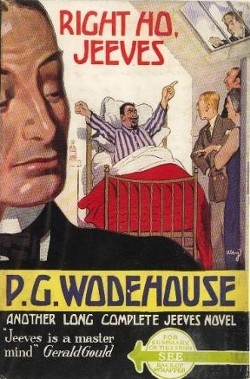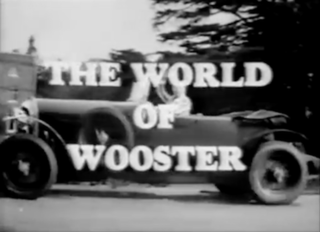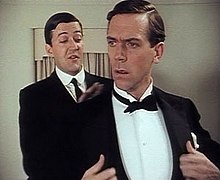
Bertram Wilberforce Wooster is a fictional character in the comedic Jeeves stories created by British author P. G. Wodehouse. An amiable English gentleman and one of the "idle rich", Bertie appears alongside his valet, Jeeves, whose intelligence manages to save Bertie or one of his friends from numerous awkward situations. Bertie Wooster and Jeeves have been described as "one of the great comic double-acts of all time".

Augustus "Gussie" Fink-Nottle is a recurring fictional character in the Jeeves novels of comic writer P. G. Wodehouse, being a lifelong friend of Jeeves's master Bertie Wooster and a country member of the Drones Club. He wears horn-rimmed spectacles and studies newts.

Madeline Bassett is a fictional character in the Jeeves stories by English comic writer P. G. Wodehouse, being an excessively sentimental and fanciful young woman to whom Bertie Wooster intermittently, and reluctantly, finds himself engaged.

Roderick Spode, 7th Earl of Sidcup, often known as Spode or Lord Sidcup, is a recurring fictional character in the Jeeves novels of English comic writer P. G. Wodehouse. In the first novel in which he appears, he is an "amateur dictator" and the leader of a fictional fascist group in London called the Saviours of Britain, also known as the Black Shorts. He leaves the group after he inherits his title.

Right Ho, Jeeves is a novel by P. G. Wodehouse, the second full-length novel featuring the popular characters Jeeves and Bertie Wooster, after Thank You, Jeeves. It was first published in the United Kingdom on 5 October 1934 by Herbert Jenkins, London, and in the United States on 15 October 1934 by Little, Brown and Company, Boston, under the title Brinkley Manor. It had also been sold to the Saturday Evening Post, in which it appeared in serial form from 23 December 1933 to 27 January 1934, and in England in the Grand Magazine from April to September 1934. Wodehouse had already started planning this sequel while working on Thank You, Jeeves.

By Jeeves, originally Jeeves, is a musical with music by Andrew Lloyd Webber, and lyrics and book by Alan Ayckbourn. It is based on the series of novels and short stories by P. G. Wodehouse that centre around the character of Bertie Wooster and his loyal valet, Jeeves.

Stiff Upper Lip, Jeeves is a novel by P. G. Wodehouse, published in the United States on 22 March 1963 by Simon & Schuster, Inc., New York, and in the United Kingdom on 16 August 1963 by Herbert Jenkins, London. It is the ninth of eleven novels featuring Bertie Wooster and his valet Jeeves.

The Code of the Woosters is a novel by P. G. Wodehouse, first published on 7 October 1938, in the United Kingdom by Herbert Jenkins, London, and in the United States by Doubleday, Doran, New York. It was previously serialised in The Saturday Evening Post (US) from 16 July to 3 September 1938, illustrated by Wallace Morgan, and in the London Daily Mail from 14 September to 6 October 1938.

The Mating Season is a novel by P. G. Wodehouse, first published in the United Kingdom on 9 September 1949 by Herbert Jenkins, London, and in the United States on November 29, 1949, by Didier & Co., New York.

The World of Wooster is a comedy television series, based on the Jeeves stories by author P. G. Wodehouse. The television series starred Ian Carmichael as English gentleman Bertie Wooster and Dennis Price as Bertie's valet Jeeves.
"The Ties That Bind" is the sixth episode of the fourth series of the 1990s British comedy television series Jeeves and Wooster. It is also called "The Ex's Are Nearly Married Off". It first aired in the UK on 20 June 1993 on ITV.
"Jeeves' Arrival" is the first episode of the first series of the 1990s British comedy television series Jeeves and Wooster. It is also called "In Court after the Boat Race" or "Jeeves Takes Charge". It first aired in the UK on 22 April 1990 on ITV. The episode aired in the US on 11 November 1990 on Masterpiece Theatre.
"The Hunger Strike" is the fourth episode of the first series of the 1990s British comedy television series Jeeves and Wooster. It is also called "How Does Gussie Woo Madeline?". It first aired in the UK on 13 May 1990 on ITV. The episode aired in the US on 2 December 1990 on Masterpiece Theatre.
"Will Anatole Return to Brinkley Court?" is the fifth episode of the first series of the 1990s British comedy television series Jeeves and Wooster. It is also called "Brinkley Manor" or "The Matchmaker". It first aired in the UK on 20 May 1990 on ITV. The episode aired in the US on 9 December 1990 on Masterpiece Theatre.
"Jeeves Saves the Cow-Creamer" is the first episode of the second series of the 1990s British comedy television series Jeeves and Wooster. It is also called "The Silver Jug". It first aired in the UK on 14 April 1991 on ITV. Filming took place at Highclere Castle which was the principal location for Totleigh Towers.
"The Bassetts' Fancy Dress Ball" is the second episode of the second series of the 1990s British comedy television series Jeeves and Wooster. It is also called "A Plan for Gussie". It first aired in the UK on 21 April 1991 on ITV.
"Sir Watkyn Bassett's Memoirs" is the fifth episode of the third series of the 1990s British comedy television series Jeeves and Wooster. It is also called "Hot off the Press". It first aired in the UK on 26 April 1992 on ITV.
"Bertie Takes Gussie's Place At Deverill Hall" is the fourth episode of the third series of the 1990s British comedy television series Jeeves and Wooster. It is also called "Right Ho! Jeeves". It first aired in the UK on 26 April 1992 on ITV.
"Lady Florence Craye Arrives in New York" is the second episode of the fourth series of the 1990s British comedy television series Jeeves and Wooster. It is also called "The Once and Future Ex" and was first aired in the UK on 23 May 1993 on ITV.
"Trouble at Totleigh Towers" is the fifth episode of the fourth series of the 1990s British comedy television series Jeeves and Wooster. It is also called "Totleigh Towers". It first aired in the UK on 13 June 1993 on ITV. Some of the external scenes were filmed at Highclere Castle.











